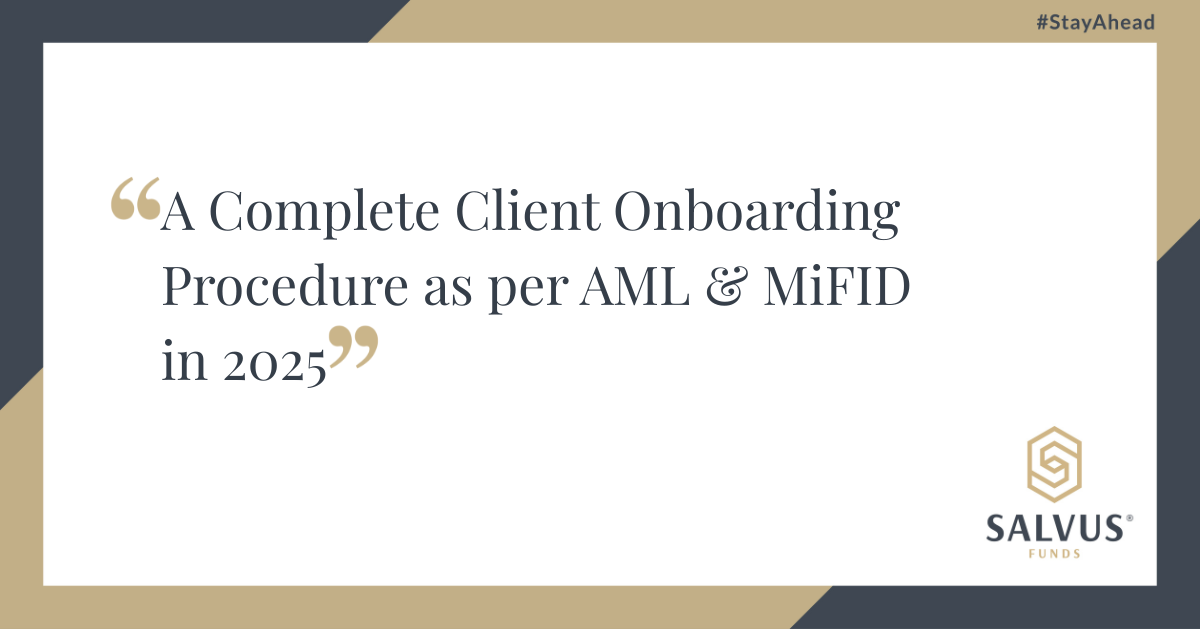A Complete Client Onboarding Procedure as per AML & MiFID in 2025
In 2025, as regulatory demands across the European Union sharpen, the process of client onboarding is no longer simply operational; it is strategic. Firms operating in investment services and ancillary roles must rigorously follow evolving rules surrounding client onboarding, particularly in relation to anti-money laundering (AML) mandates and the targeted market, suitability and appropriateness tests mandated under the MiFID II framework.
In this article, the SALVUS Regulatory Compliance team outlines the key aspects of a compliant client onboarding framework as required under AML and MiFID II, addressing the following:
1. What does client onboarding mean under AML and MiFID II?
2. What are the key components of a compliant onboarding procedure?
3. How should firms perform client due diligence (CDD) and risk scoring?
4. How can technology support effective onboarding?
5. How can SALVUS assist you?
We regularly share bite-sized insights on LinkedIn such as those found in this article
1. What does client onboarding mean under AML and MiFID II?
Under the AML Directive (AMLD6) and MiFID II, client onboarding refers to the process through which firms verify the identity, suitability, and risk profile of clients before providing investment services. It combines Know Your Customer (KYC), Customer Due Diligence (CDD), and Suitability/Appropriateness Assessments into a structured compliance process.
AML laws require firms to identify and verify clients, beneficial owners, and the source of funds to prevent money laundering and terrorist financing. MiFID II, on the other hand, focuses on ensuring that investment services and products are suitable and appropriate for each client type, whether retail, professional, or eligible counterparty.
Together, these frameworks ensure that firms operate transparently and responsibly, protecting both market integrity and investors.
2. What are the key components of a compliant onboarding procedure?
A robust onboarding process under AML and MiFID II typically includes:
- Client identification and verification: Collecting official documents to confirm the client’s identity and legal status.
- Beneficial ownership assessment: Identifying the natural persons who ultimately own or control a legal entity.
- Risk assessment and scoring: Categorising clients into low, medium, or high risk based on geographic, transactional, and behavioural factors.
- Suitability and appropriateness testing: Determining whether a product or service aligns with the client’s knowledge, experience, financial situation, and investment objectives.
- Ongoing monitoring: Continuously reviewing client activity to detect changes in behaviour, ownership, or risk profile.
These procedures must be well-documented, regularly updated, and supported by clear internal controls and record-keeping practices.
3. How should firms perform client due diligence (CDD) and risk scoring?
Client Due Diligence (CDD) is central to AML compliance and is required before, during, and after entering into a business relationship.
Key steps include:
- Collecting accurate KYC information and verifying identity with reliable documents.
- Assessing the beneficial owners of corporate clients to ensure transparency of control.
- Implementing AML risk scoring frameworks that evaluate geographic, transactional, and behavioural risk factors to categorize clients as low, medium, or high risk.
- Escalating higher-risk clients for enhanced due diligence and senior compliance review.
These elements as fundamental building blocks for designing a compliant and effective onboarding procedure in line with AML and MiFID II requirements.
4. How can technology support effective onboarding?
Technology, particularly remote onboarding solutions, can enhance client onboarding by improving efficiency and compliance. Key capabilities highlighted include:
- Remote identity verification, enabling firms to collect and verify client information without physical meetings.
- Facilitating suitability and appropriateness assessments, using technological tools to support evaluation of client knowledge, experience, and profile.
- Pre-implementation assessment and quality assurance, ensuring that onboarding solutions function correctly and comply with regulatory standards.
- Streamlined data collection and review, reducing manual errors and improving operational efficiency.
By integrating these technological solutions, firms can create a more effective, compliant, and client-friendly onboarding process.
5. How can SALVUS assist you?
At SALVUS, we assist regulated entities in strengthening their compliance frameworks for client onboarding under AML and MiFID II. Our support includes:
- Designing and implementing structured KYC, CDD, and suitability/appropriateness procedures in line with regulatory expectations.
- Assisting with risk assessment and scoring frameworks to categorize clients and manage higher-risk cases effectively.
- Advising on technology integration, including remote onboarding solutions and workflow optimization, to improve efficiency and accuracy.
- Preparing internal policies, procedures, and training programmes tailored to AML and MiFID II client onboarding requirements.
- Providing ongoing guidance and support to ensure compliance during supervisory reviews and internal audits.
SALVUS Funds, in collaboration with the Institute for Professional Excellence (IforPE), offers an online self-paced course entitled “A Complete Client Onboarding Procedure as per AML & MiFID in 2025” course offers financial institutions and investment firms the comprehensive framework needed to design and implement a compliant onboarding workflow. By integrating Anti-Money Laundering (AML) requirements, Know-Your-Customer (KYC) and Customer Due Diligence (CDD) practices, as well as MiFID II’s suitability and appropriateness assessments, the curriculum equips professionals to build a process that safeguards against financial crime, meets supervisory expectations, and supports a superior client experience.
Our team ensures that firms meet their obligations under both AML and MiFID II, enhancing client experience while minimizing regulatory and operational risks.
If you are interested in A Complete Client Onboarding Procedure as per AML & MiFID in 2025, reach out to us at info@salvusfunds.com we’re ready to answer your questions.
#StayAhead
Should you be interested to read more about organizational and operational requirements, AML compliance or compliance function requirements, please visit the selected articles below:
- Review of Regulatory Updates and CySEC Circulars Quarter 1, 2025
- Developing a Compliant AML Manual in 2025: Best Practices for Regulated Firms
- How to Get Prepared for an Inspection by the Regulator in 2025
The information provided in this article is for general information purposes only. You should always seek professional advice suitable for your needs.

